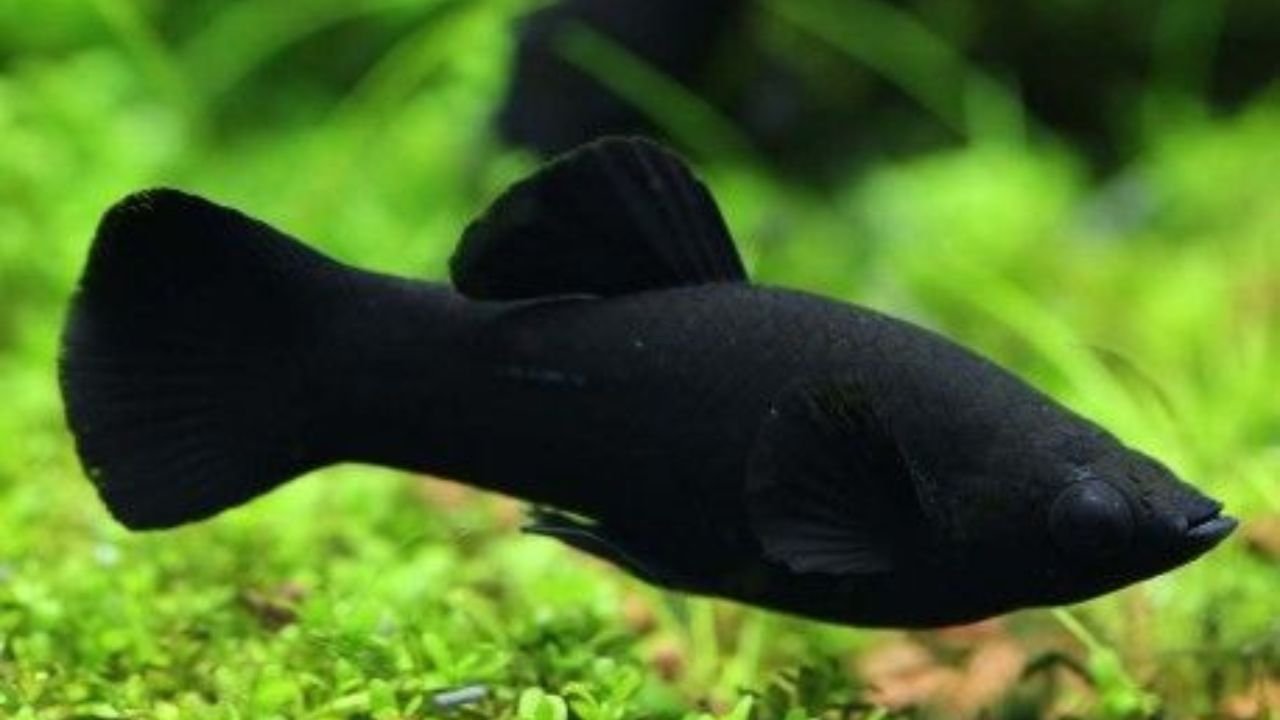Black Molly Fish Care Guide: Tank Setup, Feeding, Breeding & More
Want a calm and easy fish for your tank? The Black Molly Fish is a great choice. These fish are all black, peaceful, and easy to care for. They are perfect for new fish keepers.
This guide will show you how to care for them. You will learn how to set up the tank, what to feed them, how they breed, and how to keep them healthy. If you’re just starting or want to learn more, this guide is for you.
What Is a Black Molly Fish?
The Black Molly is a freshwater fish. It is all black and very pretty. These fish come from warm rivers in Central and South America. People bred them to be black. They are peaceful and easy to care for.
Quick Facts:
- Size: 3–4.5 inches (7–11 cm)
- Lifespan: 3–5 years
- Temperament: Peaceful
- Difficulty: Easy to Moderate
- Water Type: Freshwater (can tolerate brackish)
They’re excellent for community tanks and thrive in groups, making them a favorite among aquarists of all skill levels.
- Aquarium Moss
- Coral Beauty Angelfish
- Dwarf Pufferfish Care
- Aquarium Filter
- Swordtail Fish
- Planted Aquarium Lighting

Setting Up the Perfect Tank for Black Molly Fish
Black Mollies are fun to watch. They swim a lot and look great. To keep them happy, you need to give them the right home. Here’s how to do that:
Ideal Tank Conditions:
- Tank Size: Use a 20-gallon tank or bigger. A small group (3–4 fish) needs space to swim.
- Water Heat: Keep the water warm, between 72°F and 82°F (22°C–28°C). A heater helps.
- Water pH: Keep it between 7.5 and 8.5.
- Water Hardness: Hard water is best for mollies.
- Filter: Use a good filter. Clean water keeps them safe and happy.
Tank Tips:
- Add live plants like Java Fern or Anubias. Plants give them places to hide.
- Leave space for swimming—these fish like to move.
- Use soft gravel or sand at the bottom. It looks nice and is safe for them.
- Change some of the water each week (20–25%) to keep it clean.
Pro Tip: While they can tolerate slightly brackish water, freshwater is perfectly fine if kept clean and well-filtered.

What Do Black Molly Fish Eat?
Mollies are omnivores, meaning they eat both plant and animal matter. In the wild, they graze on algae, plant debris, and tiny invertebrates. In captivity, you can replicate a balanced diet easily.
Best Food for Black Mollies:
- High-quality flakes or pellets (specifically for tropical fish)
- Blanched veggies (zucchini, spinach, peas)
- Frozen or live food (brine shrimp, daphnia, bloodworms)
- Algae wafers for grazing
Feeding Schedule:
- Feed once or twice daily.
- Only provide what they can eat in 2–3 minutes to avoid waste buildup.
Tip: Overfeeding is a common beginner mistake—keep it light and consistent.
Black Molly Fish Tank Mates
Black Mollies are peaceful and social, but they do best with compatible tank mates that match their temperament and water needs.
Best Tank Mates:
- Guppies
- Platies
- Swordtails
- Tetras
- Corydoras Catfish
- Zebra Danios
Avoid These:
- Betta fish (can be territorial)
- Cichlids (too aggressive)
- Goldfish (different water parameters)
Keep them in groups of 3 or more for optimal comfort and natural behavior.
How to Breed Black Molly Fish
One of the coolest things about Black Mollies? They’re livebearers—meaning they give birth to free-swimming fry instead of laying eggs.

How to Tell Male vs. Female:
- Males: Smaller, slimmer, with a pointed gonopodium (reproductive fin)
- Females: Larger, rounder belly, with a fan-shaped anal fin
Breeding Tips:
- Keep a ratio of 2–3 females per male to reduce stress.
- Provide hiding spots for fry (plants, breeding boxes).
- Fry will be born every 30–45 days, often 20–100 at a time.
Pro Tip: Adult mollies may eat their fry—move the babies to a separate nursery tank if you want higher survival rates.
Common Health Issues & How to Avoid Them
Black Mollies are hardy, but they’re not immune to aquarium problems. Here’s what to watch for:
Common Diseases:
- Ich (white spot disease) – Caused by parasites, appears as tiny white dots
- Fin Rot – Ragged or decaying fins due to poor water quality
- Velvet – Gold or rust-colored dust on body, caused by parasites
- Constipation – Often from overfeeding or lack of fiber
Prevention Tips:
- Maintain clean water with proper cycling
- Avoid sudden temperature or pH changes
- Quarantine new fish for 2 weeks before introducing to main tank
Final Thoughts: Is the Black Molly Right for You?
If you’re looking for a hardy, peaceful, and beautiful fish that plays well with others and even breeds easily, the Black Molly Fish is a solid choice. With just a bit of setup and regular care, they’ll thrive in your aquarium and bring life to your underwater world.
So what are you waiting for?
Ready to build your dream aquarium?
Check out our full guide on Best Freshwater Fish for Beginners and learn how to create a balanced tank from the ground up.
Or head to our fish care shop to grab mollies, tanks, and feeding essentials now!
FAQ
Q: Can Black Molly Fish live with goldfish?
A: No. Goldfish prefer cooler water and have different care needs.
Q: How many Black Mollies should I keep together?
A: Start with a group of at least 3—they’re social and do best in small schools.
Q: Do Black Mollies need a heater?
A: Yes. Tropical fish like mollies thrive in warm, stable water.
Q: How often do Black Mollies have babies?
A: Roughly every 30–45 days, under ideal breeding conditions.

